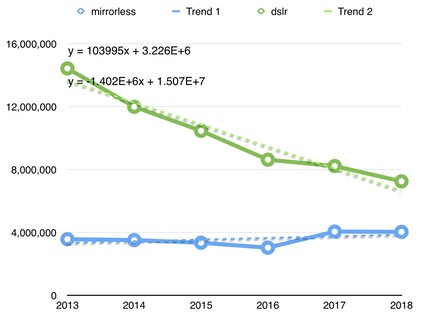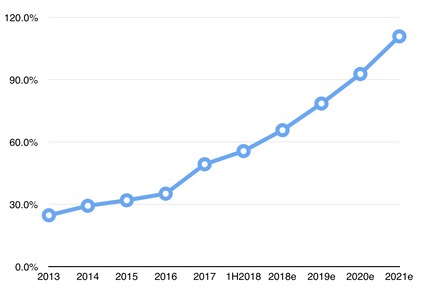People keep asking me to compare the various full frame mirrorless systems now that the three major camera companies all have one. It's important to understand where we're at, plus where we will be going in the near future if you're going to make an intelligent decision.
Sony, of course, has a large head start, as they're now on their third generation of product and have filled out their lens line pretty fully. Here's what that looks like against the new Canon and Nikon entries (lenses in parentheses are known to be coming in the next year or so, either through leaks or through published or stated road maps):
| Canon | Nikon | Sony | |
|---|---|---|---|
| Cameras |
30mp R |
24mp Z6 45mp Z7 |
12mp A7Sm2 24mp A7m3 24mp A9 42mp A7Rm3 |
| Lenses |
24-105mm f/4 28-70mm f/2 35mm f/1.8 macro 50mm f/1.2 (16-35mm f/2.8) (24-70mm f/2.8) (70-200mm f/2.8) |
24-70mm f/4 35mm f/1.8 50mm f/1.8 (14-24mm f/2.8) (14-30mm f/4) (20mm f/1.8) (24mm f/1.8) (24-70mm f/2.8) (50mm f/1.2) (58mm f/0.95) (70-200mm f/2.8) (85mm f/1.8) |
12-24mm f/4 16-35mm f/2.8 16-35mm f/4 24-70mm f/2.8 24-70mm f/4 24-105mm f/4 24-240mm f/3.5-6.3 28mm f/2 28-70mm f/3.5-5.6 28-135mm f/4 35mm f/1.4 35mm f/2.8 50mm f/1.4 50mm f/1.8 50mm f/2.8 macro 55mm f/1.8 70-200mm f/2.8 70-200mm f/4 85mm f/1.4 85mm f/1.8 90mm f/2.8 macro 100mm f/2.8 100-400mm f/4 400mm f/2.8 (24mm f1.4) (135mm f/1.8) |
| Significant Third-Party |
18mm f/2.8 Z 21mm f/2.8 Z 24mm f/2.8 S 25mm f/2 Z 25mm f/2.4 Z 28-75mm f/2.8 T 35mm f/2 Z 35mm f/2.8 S 50mm f/1.4 S 50mm f/2 Z 85mm f/1.8 Z 85mm f/2.4 Z 135mm f/2.8 Z (40mm f/2 Z) |
||
| Maker DSLR-mirrorless Adapters | EOS EF |
Nikon F |
Sony A |
S = Samyang, T=Tamron, Z=Zeiss (for the moment I've ignored Sigma, for reasons I'll get to in a moment)
So that's basically what you can count on at the moment in the three systems.
The next question that's asked is what's likely to happen next? Here are my thoughts:
- Canon — Canon will introduce at least one more body in the next six months to a year, probably beneath the current R, and likely more akin to the 6Dm2. They'll also start talking more about future RF lens plans (in Tokyo, they've already discussed having an f/2.8 zoom trio soon, which is why that's in parentheses in the table, above). I think it also likely that we'll see third-party lens support pop up fairly quickly, too. Sigma can easily do the same thing for RF they did for FE, which is to take the Art lenses and add a tube with the right bayonet at the back. Beyond that, everything is hazy still. EOS M doesn't play nicely with EOS R. EOS Cinema is still EF. So it's a little tough to understand how R fits into the overall Canon plan.
- Nikon — Surprisingly, Nikon did give us a road map for lenses for a change, with nine lenses identified and eight more without definitions yet. That would be a very fast ramp and reduce most of the disparity with Sony you see in the table within a couple of years, even with Sony producing more lenses. Where things are hazy in the Nikon realm is what happens next with bodies. Where DX (crop sensor) fits in no one knows. Why the mirrorless Z bodies were pushed somewhat more consumer than the equivalent DSLRs also brings up questions. Still, Nikon's start looks more "system-like" than Canon's so far. It will be important for Nikon to continue to push that thought in consumer minds.
- Sony — We haven't seen the A7Sm3 yet, and it most certainly is brewing in the R&D garage. Everyone expects an A9m2 next year, too. So the constant iteration on the bodies should continue. The question is whether Sony correctly now understands their ergonomic and UI liabilities and is addressing them in future bodies. I continue to hear about lenses to fill out the FE line, too, though I think we'll see things slow a bit there in terms of pace.
As I've written in comments on other sites, the real question is this: have Canon and Nikon done enough to stop the sampling, leaking, and switching I've been writing about for some time now? And if they have, then the next questions are: (1) how fast will the DSLR to mirrorless transition at each occur? and (2) where do new users for a mount come from?
So let me address those questions with some early guesses at the answers.
Canon (barely) did enough to stop the sampling, leaking, and switching. One body won't hold serve, though. Nikon did do enough to stop the sampling, leaking, and switching at the full frame level, and they could shore that up easily by substantive firmware updates and/or quick iteration. But note that both Canon (EOS M) and Nikon (nothing) have done something in full frame mirrorless that calls their crop sensor mirrorless strategy into question now. You not only want a strong product line at the top, but you need a strong feeder line below it.
Sony, of course, has a very strong product line at the top, but they, too, seem to not have things fully fleshed out in the crop sensor line that should feed it. For now, they're relying on discounts on older models to give them a crop sensor line, and they've been ignoring the lens demands for some time now (buzz, buzz ;~).
That's all part of question #2, above: where do the new users come from?
At the height of the sampling, leaking, switching, I could identify about a 5% overall market share impact away from Canon/Nikon and towards Fujifilm/Olympus/Panasonic/Sony. Because of their smaller market shares in the first place, that alone was a significant source of new users for what I used to call the Seven Dwarves (Fujifilm, Leica, Olympus, Panasonic, Pentax are really the only five left). But as I note in my answer to the first question, I think Canon and Nikon probably have staunched the leaks in the digital dike, so the sampling/leaking/switching source of new users will start drying up for the remaining Dwarves (and for Sony, who's now sort of in between the Dwarves and the Giants).
Frankly, the same thing I've been writing about for over a decade now is still true for the foreseeable future: camera sales will continue to contract until cameras are so redefined that it forces a whole new replacement cycle for everyone.
No, mirrorless is not a "whole new replacement" cycle. It's closer to an improved iteration cycle than it is a replacement. I still believe that the camera makers are missing the boat by not adopting full programmability and connectivity: even the very best implementation of a dedicated camera today results in kludgy, awkward workflow and poor performance when it comes to connecting into the modern computerized world.
Coupled with how good the image quality already is, there's no urgency for people to replace their cameras to keep up. There is a potentially decent path to some moderate benefits by moving from a DSLR to mirrorless (silent shooting, smaller/lighter equivalents, WYSIWIG viewfinder). There are also some drawbacks (battery life, new UIs for many, and cost of transitioning).
Which brings us to question #1: how fast will the transition be going from DSLR to mirrorless? I published the following chart the other day:

That implies that DSLRs will just continue to get fewer people biting for new models and updates, while mirrorless tries to hold onto the size of the market it has. I'm still predicting that it isn't until 2021 that DSLR and mirrorless camera volume becomes the same:

Percent mirrorless ILC volume versus DSLR (100% would be parity)
So the answer is this: DSLRs still have a fair amount of life in them even at the new sales level. Moreover, a Nikon D850 and a decent set of F-mount lenses could probably suit someone like me just fine from now until I can no longer spend much time out shooting (e.g. another 10 years or so), and I think that applies to a lot of other DSLR users.
The bottom line is that we have some incredible DSLRs currently available, and we now have mirrorless cameras that fairly close approach the DSLR level of performance also currently available. We live in a time of plenty: plenty of choice, plenty of performance, plenty of pixels.
The challenge for all photographers, obviously, is making the right choice for themselves.
Final thought: if you are a full frame shooter and you've been pondering switching between the three largest camera companies for some reason, now is probably the time to stop the thinking and figure out how you're going to act. You've got enough information already to see where each brand is headed and that all three companies are completely dedicated to producing a full set of products in full frame mirrorless form. Canon, Nikon, and Sony will all have complete full frame systems in the future, with the only difference being what date you consider they each reach "complete." Nikon appears to be particularly aggressive at the moment, but I think Canon is probably just as aggressive behind the scenes; they're tempering their statements a bit because they're juggling a lot of horses they want to keep running (EF-M, EF-S, EF, Cinema).
Those that need a full frame mirrorless system can now make a decision (yes, that means that I'm discounting Leica and Panasonic somewhat; those companies have slightly different targets than the main three do, and I'll bet you already know if you're in their target space or not [hint: status or video, respectively]). Those that are considering their next camera as a full frame mirrorless instead of a DSLR can today make a decision which way they'll head and start planning how their transition will likely work both time-wise and financially.
Put another way: five years out Canon, Nikon, and Sony (KonicaMinolta) are going to be about where they were five years into the DSLR era: all with complete systems and lens sets. Sony today has a slight advantage still if your need is urgent to switch to mirrorless. But that advantage will go away over time. We're going to be back where we were with film and DSLRs: three strong systems to choose from.
